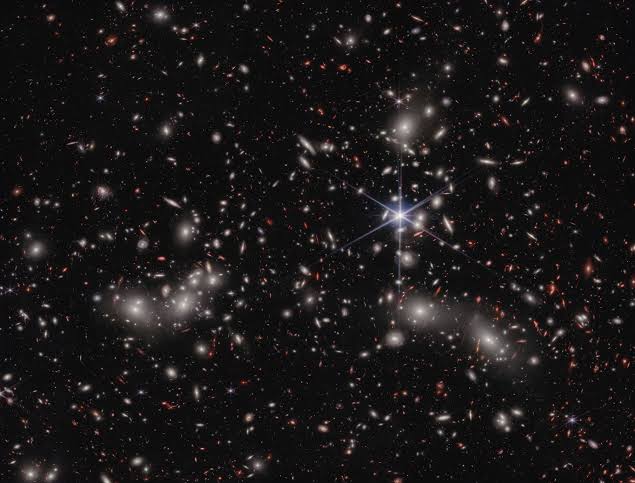NASA’s James Webb Space Telescope has revealed new details in a region of space known as Pandora’s Cluster, also known as Abell 2744. The telescope’s powerful infrared instruments have allowed astronomers to view three clusters of galaxies, which are already massive, coming together to form a mega cluster.
The combined mass of the galaxy clusters creates a powerful gravitational lens, allowing much more distant galaxies in the early universe to be observed using the cluster like a magnifying glass.
Stunning Deep-Field Image
The new deep-field image shows the never-before-seen details of the central core of Pandora’s Cluster. The new image is a combination of four Webb snapshots that have been stitched together to create one panoramic image. The image displays roughly 50,000 sources of near-infrared light. The image has exceeded the expectations of the astronomers studying the region.
The James Webb Space Telescope is the most powerful space observatory ever built. Its advanced infrared instruments allow astronomers to see deep into space and observe objects that were previously beyond our reach. The telescope’s ability to capture high-resolution images of Pandora’s Cluster is a testament to its power and precision.
As a result of its capabilities, the James Webb Space Telescope is expected to revolutionize our understanding of the universe and answer some of the most fundamental questions in astronomy.
Gravitational Lensing
Gravitational lensing is a phenomenon that occurs when the gravity of a massive object, such as a galaxy cluster, bends and warps the path of light from more distant objects behind it. The light is deflected and magnified by the massive object, creating a distorted image of the background object.
In the case of Pandora’s Cluster, the combined mass of the three galaxy clusters creates a powerful gravitational lens, which magnifies and distorts the light from much more distant galaxies, allowing them to be observed in greater detail.
The gravitational lensing effect is particularly useful for astronomers studying the early universe. The light from distant galaxies has traveled vast distances over billions of years and is thus very faint by the time it reaches Earth.
However, the gravitational lensing effect of massive galaxy clusters can amplify this faint light, making it easier to study and analyze. By studying the distorted and magnified images of these galaxies, astronomers can learn more about the conditions in the early universe and how galaxies evolved over time.
Furthermore, the gravitational lensing effect also provides astronomers with a means to measure the mass of the lensing object, such as the galaxy cluster, even when the cluster is so far away that it cannot be studied directly. By analyzing the distortions in the shapes of the distant galaxies, astronomers can infer the mass and distribution of the dark matter in the lensing galaxy cluster.
New Era of Astronomy
Astronomer Ivo Labbe of the Swinburne University of Technology in Melbourne, Australia, said that in the lensing core to the lower right in the Webb image, which has never been imaged by Hubble, Webb revealed hundreds of distant lensed galaxies that appear like faint arced lines in the image. Zooming in on the region reveals more and more of them. The image is helping scientists work in a new era of astronomy that is providing them with new insights into the early era of galaxy assembly and evolution.
The discovery of new details in Pandora’s Cluster is just one of many breakthroughs that are expected to come from the James Webb Space Telescope. With its powerful instruments and advanced capabilities, the telescope is poised to revolutionize our understanding of the universe and its origins.
Over the next few years, scientists and researchers will continue to study Pandora’s Cluster and other regions of the universe using the James Webb Space Telescope. This is expected to lead to new discoveries, new insights, and a deeper understanding of our place in the cosmos.
Insight into the Early Universe
The next step is for the UNCOVER team to go through the imaging data and select galaxies for follow-up observation with the Near-Infrared Spectrograph (NIRSpec), which will provide precise distance measurements, along with other detailed information about the lensed galaxies’ compositions, providing new insights into the early era of galaxy assembly and evolution. The UNCOVER team expects to make these NIRSpec observations in the summer of 2023.
While the initial observations of Pandora’s Cluster are exciting, they are just the beginning of a long-term study of the region. The next step for astronomers is to go through the imaging data in detail and select galaxies for follow-up observation with the Near-Infrared Spectrograph (NIRSpec).
This will provide researchers with more detailed information about the lensed galaxies’ compositions, as well as their precise distance measurements. Such information is critical for understanding the early era of galaxy assembly and evolution.
Conclusion
The James Webb Space Telescope is the world’s premier space science observatory. It will solve mysteries in our solar system, look beyond distant worlds around other stars, and probe the mysterious structures and origins of our universe and our place in it. The new deep-field image of Pandora’s Cluster is just the beginning of all the amazing Webb science to come. All the NIRCam photometric data has been publicly released so that other astronomers can become familiar with it and plan their own scientific studies with Webb’s rich datasets. Webb is an international program led by NASA with its partners, ESA (European Space Agency) and the Canadian Space Agency.
